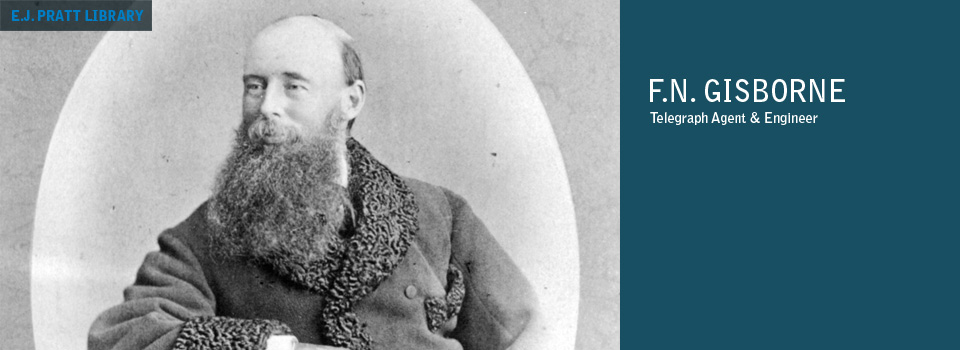Frederic Newton Gisborne
2 photographs: b&w
2 photographs: sepia
2 photographs: 35 mm b&w negatives
1 photograph: 35 mm col. slide
2 maps
1 postcard
1 print: lithograph
1 microfilm reel
2 sections of telegraphic cable
Frederic Newton Gisborne (1824–1892) was a telegraph agent, engineer and civil servant, who pioneered the construction of submarine telegraph systems. He was born in Broughton, Lancashire, England, the son of Hartley P. Gisborne. He married Alida Ellen Starr in 1850. She died in 1854, leaving him with two children. He married Henrietta Hernaman in 1857 and they had four children. He died in Ottawa, Ontario.
Gisborne came to Canada in 1845 with his brother. He farmed for two years near St. Eustace, Lower Canada. He also worked as one of the first operators for the Montreal Telegraph Company, becoming its Chief Operator. In 1847, he was appointed General Manager of the British North American Electric Telegraph Association. From 1849 to 1851, he held the position of Superintendent of Telegraphs in Nova Scotia.
During the early 1850s Gisborne began to study the possibility of a submerged trans-Atlantic cable. After he received permission from the Canadian Government to conduct a preliminary survey, he travelled to the United States to find investors. He enlisted the support of several businessmen and was appointed engineer of the private company that emerged as a result. After overseeing the establishment of an overland link from Nova Scotia through New Brunswick to the United States, in 1852 he laid a small insulated cable from New Brunswick to Prince Edward Island, thereby establishing the world’s first submarine telegraph system. A second project, to lay an overland line from Newfoundland to Nova Scotia, failed, but in the winter of 1853–54 Gisborne returned to New York where he again solicited support from investors. They formed the New York, Newfoundland and London Telegraph Company. In 1854, Gisborne went to Newfoundland as Chief Engineer of the Company and Superintendent of the submarine operation. In 1856, he succeeded in laying a cable between Cape Ray, Newfoundland and Cape Breton, Nova Scotia. He was offered a permanent position as Superintendent of the new telegraph system. When he rejected the terms offered, his connection with the company and his involvement in the construction of the trans-Atlantic telegraph system, which came to fruition in 1858, ceased.
In 1857, Gisborne was elected President of the Mining Association of Newfoundland. After several years he returned to England as a mines and minerals agent for the Government of Nova Scotia. He received several British medals for scientific inventions, including electrical and signaling devices. He returned to Canada in 1869 as Chief Engineer for an English company with investments in the coalmines of Cape Breton. In 1879, he accepted the position of Superintendent of the Telegraph and Signal Service of the Dominion Government.
Gisborne was a charter member of the Royal Society of Canada, a member of the Council of the Canadian Society of Civil Engineers, and a member of many scientific associations.
Anne C.M. Starr purchased part of the material from a bookseller at an unknown date; prior custodial history of this material is unknown. A photograph and some clippings were forwarded to Dr. Starr by Francis H. Gisborne, son of Frederic Newton Gisborne and Henrietta Hernaman. The custodial history of the remaining material is unknown.
The fonds consists of records pertaining to Gisborne's activities as an engineer. it includes a letter copybook (1856-1861); a notebook (1855-1856); a journal (1851); material about Gisborne including notes by Mrs. Starr and Sessional Papers from the British Columbia Legislative Assembly (1880, 1883, 1885, and 1899); photographs; a map of the Western Section of the Dominion of Canada Telegraph and Signal Service (No. 4); and other material.
Title based on contents of the fonds.
Acquired chiefly from Anne C.M. Starr, wife of Dr. F.N.G. Starr who was the nephew of Frederic Newton Gisborne, in 1946. Other material was acquired from Gladys Walker in 1953.
English
Restrictions on access: No restrictions on access.
File list available.
No further accruals are expected.
Provenance access points:
Gisborne, Frederic Newton, 1824–1892
The fonds is stored in 2 boxes.
Individual files contain photocopies of originals. For location of originals see description in file lists.
The rare book collection at Victoria University Library contains a copy of The Story of the Telegraph and a History of the Great Atlantic Cable by Charles F. Briggs and Augustus Maverick (New York: Rudd & Carleton, 1858), 255 p. Ill. Map, one copy annotated by F.N. Gisborne. This title is also available as an online resource through the UTL Catalogue and in microtext at Robarts Library.
Biographical information see: Gwynneth C.D. Jones "Gisborne, Frederic Newton" in Dictionary of Canadian Biography, vol. 12, University of Toronto/Université Laval, 2003.
Telegraph in Western Canada, 1883—Government—Canada at Scale: Maps of our History—Exhibitions: Library and Archives Canada, Ottawa.
Library and Archives Canada, Ottawa, Exhibitions: Telegraph in Western Canada, 1883. Canada at Scale: Maps of our History.
Library and Archives Canada: Frederick Newton Gisborne fonds (reference number: none; was: MG55/24-No.41) and related collections.
Memorial University, Digital Archives Initiative, Centre for Newfoundland Studies, Digital Books. Gisborne’s Journal of an Electric Telegraph Survey in Newfoundland, 1851. This is a typescript copy of the journal held in Box 1 File 3 of the Frederic Newton Gisborne collection at Victoria University Library.
"Frederic Newton Gisborne," History of the Atlantic Cable and Undersea Communications.... By Bill Burns.
 Ask Us
Ask Us
